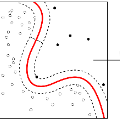Statistical analysis of magnetic resonance imaging (MRI) can help radiologists to detect pathologies that are otherwise likely to be missed. Deep learning (DL) has shown promise in modeling complex spatial data for brain anomaly detection. However, DL models have major deficiencies: they need large amounts of high-quality training data, are difficult to design and train and are sensitive to subtle changes in scanning protocols and hardware. Here, we show that also simple statistical methods such as voxel-wise (baseline and covariance) models and a linear projection method using spatial patterns can achieve DL-equivalent (3D convolutional autoencoder) performance in unsupervised pathology detection. All methods were trained (N=395) and compared (N=44) on a novel, expert-curated multiparametric (8 sequences) head MRI dataset of healthy and pathological cases, respectively. We show that these simple methods can be more accurate in detecting small lesions and are considerably easier to train and comprehend. The methods were quantitatively compared using AUC and average precision and evaluated qualitatively on clinical use cases comprising brain atrophy, tumors (small metastases) and movement artefacts. Our results demonstrate that while DL methods may be useful, they should show a sufficiently large performance improvement over simpler methods to justify their usage. Thus, simple statistical methods should provide the baseline for benchmarks. Source code and trained models are available on GitHub (https://github.com/vsaase/simpleBAD).
翻译:对磁共振成像(MRI)进行统计分析,可以帮助放射学家发现本有可能错失的病理学。深度学习(DL)在模拟复杂的空间数据以发现大脑异常现象方面显示了希望。然而,DL模型有重大缺陷:它们需要大量高质量的培训数据,难以设计和培训,而且对扫描协议和硬件的微妙变化敏感。在这里,我们表明,简单统计方法,如Voxel-wis(基线和变量)模型和使用空间模式的线性投影方法,在不受监督的病理学探测中可以达到DL-等值(3D 卷状自动电解码)的性能。所有方法都经过了培训(N=395)和比较(N=44),分别需要大量新的、专家的多参数(8个序列),用于健康和病理学案例。我们表明,这些简单方法在探测小的损害方面可以更加精确,并且更易于培训和理解。方法是用AUC和平均的精确性评估临床使用案例,包括大脑萎缩、肿瘤/肿瘤的临床基准。在经过训练的统计学上可以展示一个较简单的底的成绩方法,同时,可以充分证明其基础方法。(小的改进。在可以说明其基础方法上可以提供。



